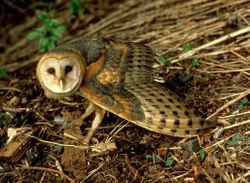|
Barn-owls |

Barn Owl, Tyto alba
|
|
Scientific classification |
| Kingdom: |
Animalia
|
| Phylum: |
Chordata
|
| Class: |
Aves
|
| Order: |
Strigiformes
|
| Family: |
Tytonidae
Ridgway, 1914 |
|
|
Genera |
Tyto
Phodilus
For fossil genera, see article. |
Barn-owls (family Tytonidae) are one of the
two generally accepted families of owls, the other being the
typical owls, Strigidae. They are medium to large sized
owls with large heads and characteristic heart-shaped faces.
They have long strong legs with powerful talons. The barn
owls comprise two extant sub-families: the Tytoninae or Tyto
owls (including the Common Barn Owl) and the Phodilinae or bay-owls.
The barn owls are a wide ranging family, absent only from
northern North America, Saharan Africa and large areas of
Asia. They live in a wide range of habitats from deserts to
forests, and from temperate latitudes to the tropics. The
majority of the 16 living species of barn owls are poorly
known, some, like the Madagascar Red Owl, have barely been seen or studied
since their discovery, in contrast to the Common Barn Owl,
which is one of the best known owl species in the world.
However, some sub-species of the Common Barn Owl possible
deserve to be a species, and are very poorly known.
5 species of barn-owl are threatened, and some island
species have gone
extinct during the
Holocene or earlier (e.g. Tyto pollens, known from the
fossil record of Andros Island, and possibly the basis for
the Chickcharnie). The barn-owls are mostly nocturnal, and generally non-migratory,
living in pairs or singly.
Description
The barn-owls main characteristic is the heart-shaped
facial disc, formed by stiff
feathers which serve to amplify and locate the source of
sounds when hunting. Further adaptations in the wing
feathers eliminate sound caused by flying, aiding both the
hearing of the owl listening for hidden prey and keeping the
prey unaware of the owl. Barn-owls overall are darker on the
back than the front, usually an orange-brown colour, the
front being a paler version of the back or mottled, although
there is considerable variation even amongst species. The
bay-owls closely resemble the Tyto owls but have a
divided facial disc, ear tufts, and tend to be smaller.
Species
The fossil record of the barn-owls goes back to the
Eocene, with the family eventually losing ground to the true
owls after the radiation of rodents and owls during the
Neogene epoch . Two subfamilies are only known from the
fossil record, the Necrobyinae and the
Selenornithinae. Numerous extinct species of Tyto
have been described; see the genus page for more
information.
- Genus
Tyto
- Greater Sooty-owl, T. tenebricosa
Lesser Sooty-owl, T. multipunctata
Australian Masked-owl, T. novaehollandiae
Golden Masked-owl, T. aurantia
-
Lesser Masked-owl, T. sororcula
- Buru Masked-owl, T. (sororcula) cayelii
(possibly
extinct)
- Manus Masked-owl, T. manusi
Taliabu Masked-owl, T. nigrobrunnea
Minahassa Masked-owl, T. inexspectata
Sulawesi Owl, T. rosenbergii
-
Barn Owl, T. alba
- Eastern Barn Owl, T. (alba) delicatula
- Ashy-faced Owl, T. glaucops
Madagascar Red Owl T. soumagnei
African Grass-owl T. capensis
Australasian Grass-owl T. longimembris
- Genus
Phodilus
-
Oriental Bay-owl P. badius
- Samar Bay-owl P. (badius) riverae
(probably
extinct)
-
Congo Bay-owl, P. prigoginei - sometimes
placed in Tyto
-
Fossil genera
- Necrobyas (Late Eocene/Early Oligocene - Early
Miocene of France)
Prosybris (Early Miocene of France)
Nocturnavis
Palaeobyas
Palaeotyto
Selenornis
The presumed "Easter Island Barn-owl", based on
subfossil bones found on Rapa Nui, has turned out to be some
procellarid (Steadman, 2006).
References
- Bruce, M. D. (1999): Family Tytonidae
(Barn-owls). In: del Hoyo, J.; Elliott, A. &
Sargatal, J. (eds):
Handbook of Birds of the World, Volume 5: Barn-owls
to Hummingbirds: 34-75, plates 1-3. Lynx Edicions,
Barcelona.
ISBN 84-87334-25-3
- Steadman, David William (2006): Extinction
and Biogeography of Tropical Pacific Islands Birds.
University of Chicago Press.
ISBN 0226771423.
External links




